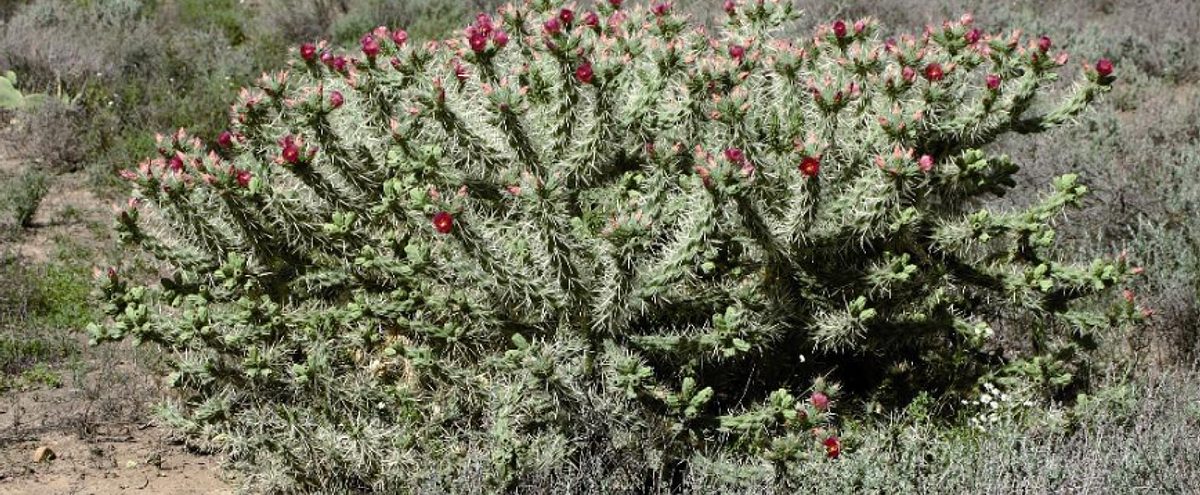
Cylindropuntia and Austrocylindropuntia cacti

Cylindropuntia (including Austrocylindropuntia) cacti are characterised by their cylindrical limbs and include commonly known species such as devil's rope, Hudson pear and pencil cactus. All Cylindropuntia species are declared in South Australia.
What are Cylindropuntia cacti?
Cylindropuntia cacti are perennial succulents characterised by cylindrical limbs and prickly spines. Most Cylindropuntia species produce flowers, ranging from pink to purple, red, magenta, greenish yellow and yellowish brown in colour, depending on the particular species. All species produce fleshy fruit which attach to the pads (or cladodes) and range in colour from green-yellow to red. The fruit of jumping cholla (Cylindropuntia fulgida) form chains.

Cylindropuntia infestations germinate easily as they can grow from both seeds and plant parts. Seeds and dislodged plant parts can travel significant distances via wind, through waterways and animals before establishing new incursions. Fruit and seeds are also spread by being ingested by birds and animals before being excreted.
Where are Cylindropuntia cacti found?
In Australia, Cylindropuntia species are found in sub-humid, semi-arid, and arid areas in sub-tropical, tropical, warm, and cool temperate regions. All Cylindropuntia species are drought resistant and can grow in a variety of soil types.
Devil’s rope is the most common species with scattered patches in the mid Murray and Riverland. White-spined Hudson pear has been recorded in the mid Murray while brown-spined Hudson pear has been spotted in the Riverland. Other species can be found near former garden sites anywhere in South Australia north and west of the Murray River. Cylindropuntia can be found in grasslands, bushlands, forests, native vegetation, and on rocky slopes, roadsides, agricultural land, railways, and waterways.
Both species of Austrocylindropuntia (cane cactus and Eve’s needle cactus) are found in the Riverland, and it is suspected that the original incursion escaped from old garden plantings. Both species are drought resistant and grow in semi-arid regions.
Eve’s needle cactus prefers free-draining soil with either neutral to alkaline pH and is tolerant of infertile, saline, and shallow soils. Austrocylindropuntia can be found in grasslands, shrublands, and open woodlands and alongside roadsides and waterways.

Recorded Cylindropuntia and Austrocylindropuntia outbreaks in the Murraylands and Riverland region*
What are the impacts of Cylindropuntia?
Species of Cylindropuntia and Austrocylindropuntia invade rangelands, pastoral land, and open native vegetation, displacing and competing with desirable vegetation. Dense infestations obstruct movement by stock, humans, and vehicles and the fruits of some species can harbor fruit fly. The spines can injure people, native animals, livestock, working dogs, and pets and also damage tyres on vehicles and penetrate footwear. The presence of spines in wool and hides reduces their value and causes issues with shearing.
Spines in some Cylindropuntia species are encased in a detachable sheath which may remain embedded in a wound even after the body of the spine is removed. Spines have been known to kill wildlife, including koalas.

What is the declared status of Cylindropuntia and Austrocylindroptunia species?
All species of Cylindropuntia are declared in South Australia and subject to the following restrictions:
- Land managers must take reasonable steps to kill plants and prevent their spread,
- Plants must not be sold or traded in any way, including as a contaminant of anything,
- Plants must not be transported on a public road, including as a contaminant of anything, and
- Plants must not be transported into the region without a permit.
Both species of Austrocylindropuntia are declared and are subject to the following restrictions:
- Plants must not be sold or traded in any way, including as a contaminant of anything.
How can Cylindropuntia be controlled?
Managing infestations of cacti can be hard because it spreads easily from small plant parts. Successful weed control relies on follow-up after the initial efforts by looking for and killing regrowth or new plants. Using a combination of control methods is usually more successful.
Land managers should ensure they wear protective clothing, including gloves, boots, thick clothing, and eyewear to stop injuries from spines.
Visit the PIRSA website to find out chemical control options and dosing rates specific to Cylindropuntia and Austrocylindropuntia.
In some situations, manual removal may be an appropriate control option but is only effective when all parts of the plant are removed and buried deeply.
There is also a biocontrol option which is effective in managing devil's rope. To see if this appropriate for incursions on your land and to access the biocontrol, contact a district officer at your local landscape office.

How can Cylindropuntia be prevented?
Land managers should also ensure that they take relevant preventative measures. Avoid growing Cylindropuntia in gardens or pots and don't take cuttings of unknown cactus plants to grow or share with others.
Check clothing, vehicles, and equipment for plant parts before leaving an area that has cacti. Use fences to keep livestock (and wildlife if possible) out of known cacti incursions.
When is the best time to monitor for and control Cylindropuntia?
Cylindropuntia are perennial and so are visible all year around and timing for control depends on the method used. Manual removal may be conducted at any time of year, whereas some chemical control methods require certain climatic conditions and are best when the plant is actively growing so spring and summer are most suitable. Trials in the Murraylands and Riverland region have shown that biocontrol released in autumn is most likely to take to the host plant and therefore be more effective in control.
What to do if you suspect a Cylindropuntia outbreak
Notify the Murraylands and Riverland Landscape Board if assistance is required. If the plants are actively growing on your land, remove and destroy the plant or treat with a relevant herbicide until the plants are killed.


This project is supported by the Murraylands and Riverland Landscape Board with funding through the landscape levies.
*Map provided as a guide only. Mapped outbreaks are not necessarily current or comprehensive.